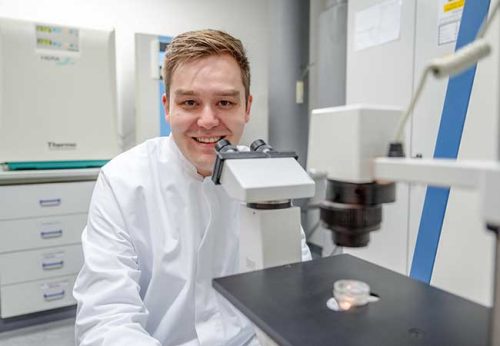Dr. Johannes Karges (31), a chemist from Ruhr University Bochum, will be awarded the Paul Ehrlich and Ludwig Darmstaedter Early Career Award 2024, the Scientific Council of the Paul Ehrlich Foundation announced today. The prizewinner discovered how platinum-containing chemotherapeutics accumulate in tumor tissue, and how, from here, they can be activated using either light or ultrasound as triggers. Karges already provided preclinical proof of these methods, whose translation into clinical practice could drastically reduce the serious side effects of these most commonly used cancer drugs worldwide and significantly increase their effectiveness.

Around half of all chemotherapy treatments worldwide are carried out with cisplatin and two of its derivatives. These cytostatic drugs prevent cancer cells from dividing, and have shown impressive success against some types of cancer for several decades already. They do, however, quickly lead to resistance. Given that platinum preparations also inhibit the division of healthy body cells, they are associated with serious side effects, which range from nausea and vomiting to kidney, hearing and nerve damage and even inhibition of blood formation in the bone marrow. That is why the search for a way to ensure these cytostatic drugs only act on the cancer cells they are intended to destroy has long been underway. This would make them similar to magic bullets in the sense of Paul Ehrlich, which only cure the disease without harming the rest of the body. The research conducted by Johannes Karges and his team has breathed new life into this vision.
The two initial questions of this research were: How can we selectively accumulate the cytostatic drug or a precursor thereof in the tumor? And, following on from this: How can we selectively activate it there? The answer lies in the construction of tiny spheres (nanoparticles) that are too large to penetrate healthy tissue, but small enough to squeeze between cancer cells. Healthy cells are tightly bound together, whereas, due to the high division rate of its cells, the connection between tumor tissue is patchy. The nanoparticles are equipped with built-in remote triggers that are activated by external signals. Photo- or sonosensitizers are suitable as receivers. These molecules have the ability to convert the energy of absorbed light or sound into chemical reactions in which electrons are released and absorbed (redox reactions).
Together with his Chinese research partner Prof. Haihua Xiao, Karges has so far successfully tested two mixtures that can be “detonated” in cancer cells using these time fuses. In the first case, he coupled the active ingredient oxaliplatin to a photosensitizer and bound both molecules into a fat-soluble polymer, onto whose ends he attached water-soluble peptides, which acted as “address labels”, so to speak, for transport into the cell nucleus. The resulting chains self-assembled into spheres with a diameter of some 80 nanometers. Once these beads reached the nucleus of the cancer cell, nothing happened – that is, as long as darkness prevailed. The moment these spheres were irradiated with red light, they disintegrated, releasing oxaliplatin and highly aggressive oxygen, and thereby destroying the cancer cells.
However, red light does not penetrate deeper than one centimeter into an organism and therefore cannot reach most human tumors. Ultrasound waves travel ten times the distance in the body. That is why, in the second case, Karges used a computer to calculate which sonosensitizers, when irradiated with ultrasound waves, could convert a non-toxic precursor (prodrug) of cisplatin into the toxic substance. He found hemoglobin to be best suited and proceeded to pack the biomolecule and the prodrug into nanoparticles in the tried and tested way. In this instance, too, the particles selectively accumulated in cancer cells. While they remained stable under physiological conditions, after sonication in the presence of ascorbic acid, it took only a few minutes for the prodrug to convert entirely into cisplatin.
Karges and Xiao were able to confirm their findings obtained in cell cultures in experiments with mice. In both of the cases described above, the tumors of the animals injected with the nanoparticles disappeared almost completely within a short time after external irradiation with red light or ultrasound.
Johannes Karges, PhD, studied chemistry at Philipps-Universität Marburg and at Imperial College London from 2011 to 2016. As a doctoral student, he conducted research in the field of bioinorganics at the École Nationale Supérieure de Chimie de Paris, France, and at Sun Yat-Sen University in Guangzhou, China. After his PhD, he worked as a postdoctoral researcher at the University of California, San Diego, in La Jolla from 2020 to 2022. Since November 2022, he has headed his own research group at Ruhr University Bochum as a Liebig Fellow of the German Chemical Industry Fund.
The Chairman of the Scientific Council of the Paul Ehrlich Foundation will present the Paul Ehrlich and Ludwig Darmstaedter Early Career Award 2024 as well as the Paul Ehrlich and Ludwig Darmstaedter Prize 2024 during a festive ceremony held 14 March 2024 at 5 p.m. in Frankfurt’s Paulskirche.









